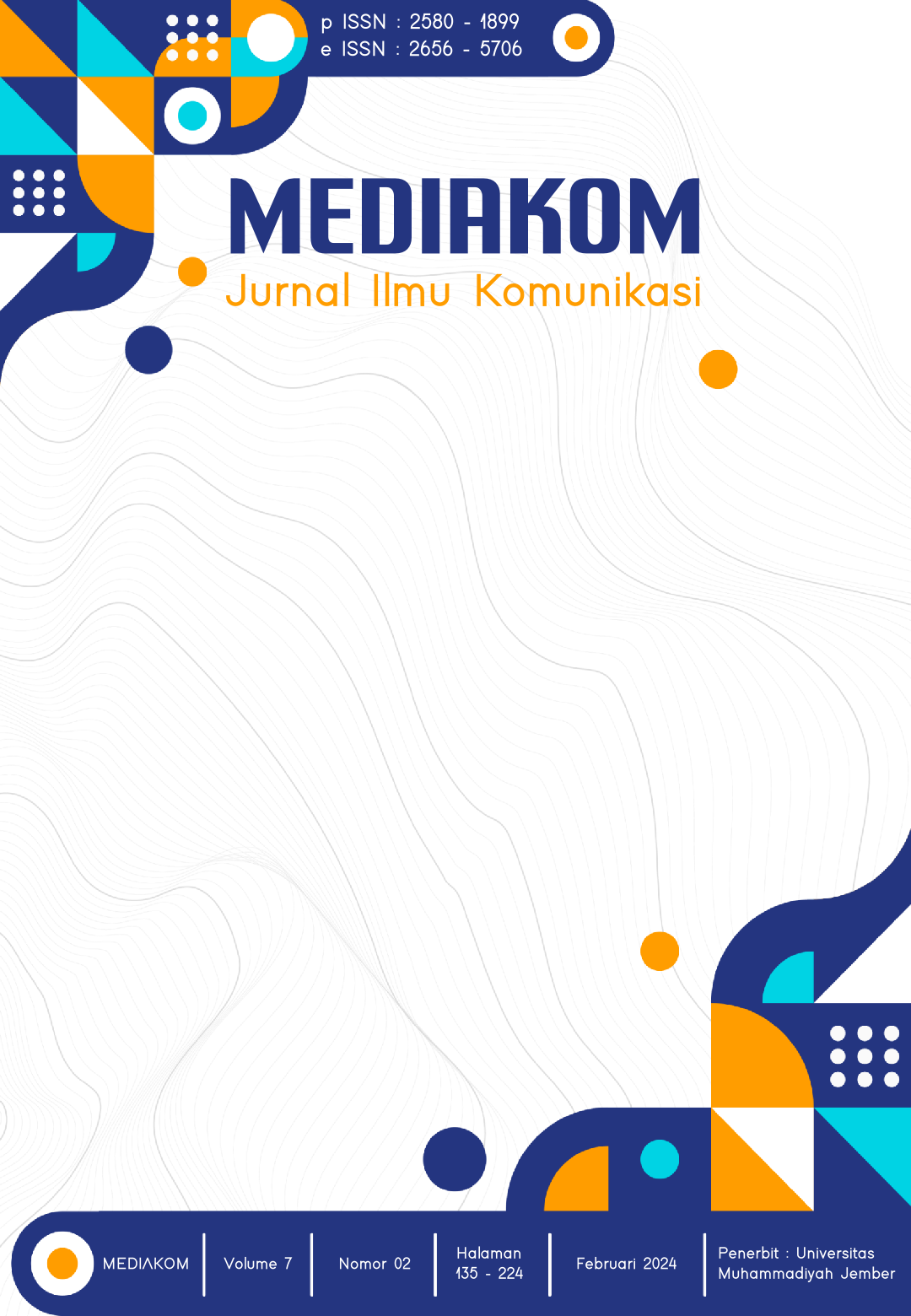RELEVANSI VISUAL IKLAN GOJEK CERDIKIAWAN TERHADAP TREN DAN PERILAKU GENERASI Z
DOI:
https://doi.org/10.32528/mediakom.v7i02.3588Keywords:
Visual Communication, Generasi Z, IKLAN DIGITAL, GOJEK, TRND, PERILAKU, ELEMEN VISUAL, KOMUNIKASI, DIGITAL, MULTITASKING, APLIKASI, MEDIA, IKLAN, ADVERTISING, KREATIF, TANDA, ELEMEN, KEBIASAAN, ONLINE, YOUTUBE, CERDIKIAWAN, RELEVANSI, MEDIA ONLINE, Communication Media, TIKTOK, INOVATIF, PROMOSI, ADAPTIF, GEN Z, SIMBOL, OBJEK, ICON, OBJECT, SYMBOL, INTERPRETANTAbstract
This study examines the role of visual elements in Gojek’s “Cerdikiawan” digital advertisement in representing visual trends and the behavior of Generation Z. The main issue explored is how visual components can reflect current trends and connect with the behaviors of young consumers. The research aims to analyze the relevance of these visual elements using Charles Sanders Peirce’s semiotic theory, which divides signs into icons, indexes, and symbols. A descriptive qualitative method was employed, with primary data gathered through interviews with five Generation Z informants and secondary data from advertisement observations. The analysis focuses on identifying visual signs in the ad and interpreting them based on the audience’s social and cultural context. The findings show that iconic signs, such as a fork used as a creative solution, symbolize innovation and efficiency—traits valued by Generation Z. Indexical signs reflect their adaptability to technology, while symbolic elements convey emotional messages that enhance Gojek’s brand image. This study offers insights into how visual advertising can emotionally engage younger audiences through semiotic interpretation.
References
Deloitte Insights. (2025). Decoding Gen Z: Unraveling Workforce Preferences, Consumer Behavior, and Financial Decision-Making in The IR 4.0. Economic Sciences, 21(1), 258-268.
Divaliani, E. S., & Nurhakim, T. F. (2024). Persepsi Generasi Z Terhadap Fitur Postingan Ulang Pada Aplikasi Tiktok. Jurnal Mutakallimin: Jurnal Ilmu Komunikasi, 7(1).
Fiske, J. (2010). Understanding popular culture. Routledge.
Gojek Indonesia. (2020, November 5). Iklan Gojek "Cerdikiawan" [Video]. YouTube. https://youtu.be/viUwhsB00i8?si=-kH9T0ShcxHkbguk
Hoed, B. (2011). Semiotika komunikasi: Dasar-dasar teori dan aplikasi dalam analisis media. Jurnal SASAK: Desain Visual dan Komunikasi, 3(2), 67-74.
Irvine, M. (2020). Triangle meaning semiotics: Peirce's triadic model patterns of Meaning–Making in Language and Society (Vol. 1). Brill.
Jefkins, F. (2018). Advertising: The communicative power of advertising in promoting products. Pearson. Journal of English in Academic and Professional Communication, 10(2), 67-99.
Johar, A. (2015). Peran media komunikasi dalam promosi dan pemasaran di era digital. Jurnal Komunikasi, 12(3), 45-59.
Martinet, R. (2010). Semiotics in Structural Linguistics. Bloomsbury Semiotics, vol. III, Semiotics in the arts and social sciences,, 261-284.
Pew Research Center. (2020). How Gen Z engages with digital media. Retrieved from https://www.pewresearch.org
Primagara, I. (2013). Kreativitas dalam iklan sebagai alat komunikasi pemasaran. Jurnal Ilmu Komunikasi, 18(2), 101-115.
Santoso, E. D., & Larasati, N. (2019). Benarkah iklan online efektif untuk digunakan dalam promosi perusahaan?. Jurnal Ilmiah Bisnis dan Ekonomi Asia, 13(1), 28-36.
Smith, J., Brown, L., & Taylor, R. (2021). The influence of social media aesthetic on young consumers. Journal of Digital Marketing, 12(3), 45-60.
Wahjuwibowo, A. (2011). Pengaruh visual dalam iklan terhadap perilaku konsumen: Studi terhadap generasi muda. Jurnal Psikologi Pemasaran, 9(4), 55-68.
Wahyudi, I., & Pratama, H. A. (2020). Strategi Pemasaran Digital Gojek dalam Meningkatkan Brand Awareness di Kalangan Generasi Muda. Jurnal Ilmu Ekonomi dan Manajemen, 25(2), 120-130.
Williams, K. (2019). Inclusivity and representation in advertising: A study of Gen Z. Communication Studies, 14(2), 22-35.
Downloads
Published
Issue
Section
License
Copyright (c) 2024 Adela ananta, Elliya Rizky Cahyani, Hendra Pradana Wiranata, M. Verdy Juliansyah, Salsabila Sari Yasmin, Dwimay Fawzy

This work is licensed under a Creative Commons Attribution-NonCommercial 4.0 International License.







